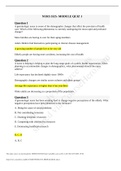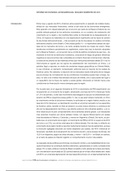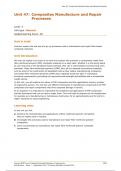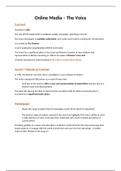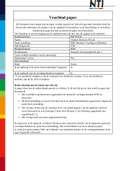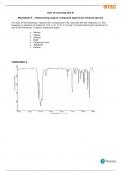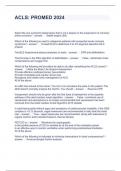1.1.1 Economics as a social science
Social scientists study and develop theories about human behavior
Economists can’t test their theories in laboratory conditions
An economic model is a simplified description of reality that’s designed to generate hypotheses about economic
behaviour that can be tested.
Economic models generally consist of a set of mathematical equations that describe a theory of economic
behaviour
Economists follow the scientific method to construct and refine their economic models
Economic theories v.s. economic models
Economic theories tend to be more broad and qualitative. A good example would be Say’s Law, which states
that ‘production creates its own demand’
Economic models use mathematical techniques such as multiple regression.
For example a bank in City might use a mathematical model to predict that an interest rate rise of 0.25% will
lead to a 20% increase in the number of people defaulting on their mortgages
Who uses economic theories and models?
Politicians are supposed to improve the quality of our lives - governments should use data and economic
theories to make better decisions, using data and logic
Economists develop theories - understand & explain what has happened in the past
Commercial organisations: examine the trends of the past
Businesses to boost their profits. Many of these models are based on correlation, or mathematical regression
The need to make simplifying assumptions in Economics
1) Economists don’t work in laboratory conditions
Labs allow natural scientists to carry out experiments that isolate the independent effect that one variable has
on another
Economists don’t have access to controlled laboratory conditions.
The ceteris paribus assumption
To enable economists to form theories in a world where variables are constantly changing, economists assume
ceteris paribus - other things being equal
For example, demand is affected by hundreds of variables other than the price of the good itself. All of these
other factors are constantly changing. However, if we assume that all of these other factors remain the same
economists theorise that there’s a negative relationship between price and quantity demanded
Law of demand – other things being equal, price cuts will lead to more being bought
2) Economists study people, not inanimate matter
Chemists and Physicists study homogenous matter
humans are heterogenous – we are all different
humans will often react inconsistently to the same stimulus
Economic models assume human behaviour is rational
Austrian economists believe that we’re rational: human action is purposeful behaviour. Our behaviour is
directed towards maximising our own satisfaction – we pursue our self-interest
Economists assume that consumers try to spend their limited money incomes in a manner that will maximise
their utility or pleasure by weighing-up private benefits and costs
Firms are assumed to be profit maximisers
Ludwig von Mises: Praxeology – “Action is, by definition, always rational.” – Action is always necessarily rational
because an acting man is always aiming his action to satisfy some desire.
Are a theory’s predictions more important than its assumptions?
The world is a complex place
Therefore, to construct economic theories simplifying assumptions must be made
Theories with very accurate assumptions don’t tend to be very useful because they tend to be merely
descriptions of reality
, This means that they perform badly in terms of their predictive power
In Economics the best theories are based on unrealistic assumption – these more abstract theories produce the
best predictions
1.1.2 Positive and normative economic statements
Positive statements are statements that can be proven to be true or false via an examination of the relevant facts.
E.g. “Tax cuts help to increase economic growth” - economists could monitor whether a economy’s economic growth
rate speeds up or slows down following tax cuts
Normative statements concerns value judgements that cannot be proven true or false via an examination of the
relevant facts.
E.g. “The government should cut taxes to help the poor” – cannot be tested as it is based on opinion
Normative economics are based on personal values and emotions. During political elections, we hear a great deal of
normative economics from politicians. Every five years a new politician comes along who claims that they have the
answers to all of our country’s economic problems. “We ought to raise the minimum wage to help the poor.” “The
rich do not pay enough tax.” These are all normative economic statements.
1.1.3 The Economic Problem
Economics is the study of the allocation of scarce resources between competing uses
A resource is scarce when there is not enough of it to go around
There is not enough of the resource to meet all of society’s wants
When resources are scarce choices have to be made - 3 basic questions must be answered.
Economists assume that:
1) We want to maximise our pleasure/ utility
2) By consuming as many goods as possible
Human wants are unlimited
Factors of production
The resources needed by firms to produce goods and services
Land: natural resources, the raw materials in the production process
Labour: the effort ppl contribute to the production
Capital: machinery, tools and buildings used in production
Entrepreneurship: an entrepreneur combines the other FoPs and find new ways to produce g/s/, develop new
g/s to bring to the market
Factors of production are paid an income from those who employ them
rent, wages, interest (bank loans), profits
* Goods and services are scarce because the factors of production used to produce them are scarce
The basic economic problem
1. What to produce, and in what quantities?
- World does not possess the resources required to produce every type of g/s that are wanted
2. How to produce?
- Needs to decide the best way to use its FoPs to create the desired output mix of g/s.
3. For whom?
- decide who will get the output from the country’s economic activity, and how much they will get
The distinction between renewable and non-renewable resources
Non-renewable resources
Non-renewable resources are natural resources from the Earth that exist in limited supply and cannot be
replaced if it is used up, e.g. copper
Fossil fuels created from non-renewable resources are still the primary source of all the power generated in
the world, due to their affordability and high energy content.
An over-reliance on non-renewable resources can reduce the living standards of future generations. Mining
can create pollution, which damages environmental goods
, In addition, if the current generation over-uses non-renewable resources there will be fewer of these resources
available for future generations
Have we achieved sustainable economic growth & development?
The economy grows when it produces more goods and services than it did the year before
Economic growth enables households to consume more, which raises the quality of life, creating economic
development
However, much of the economic growth that we have achieved has been dependent on the exploitation of non-
renewable resources
Thus neither our economic growth or our economic development is sustainable
Renewable resource
a resource that does not run out, e.g. solar, wind, wave and tidal power all have an endless supply
Economic growth and economic development that is based around the use of renewable resources is
sustainable - current generation can use renewable resources to enjoy a high quality of life without
compromising the ability of future generations to enjoy a similarly high quality of life
Inter-generational equity (fairness between the generations) - High living standards achieved and enjoyed by
today’s generation should not be at the expense of future generations
Unlike oil, solar power does not cause pollution which will affect future generations. Also the decision to use
solar power today will not mean that there will any less solar power for future generations to use
Environmental goods
an aspect of nature that generates utility (satisfaction) e.g. clean air
are not bought and sold in a conventional market difficult to value in money terms because there are no
market prices for environmental goods
Pollution created by non-renewable resources damage the quality of environmental goods, reducing society’s
non-material standard of living
Opportunity Cost
due to the problem of scarcity, difficult choices must be made. When they choose to satisfy a certain want, they
need to forgo the others Economics explains human choice by opportunity cost
Opportunity cost: the value of the next best alternative forgone
- the most valuable thing that had to be given up in order to do sth else
- could also be what you possibly can suffer from
Application
Work-leisure choices: The opportunity cost of deciding not to work an extra ten hours a week is the lost
wages foregone.
Government spending priorities: The opportunity cost of the government spending nearly £10 billion on
investment in National Health Service might be that £10 billion less is available for spending on education or
improvements to the transport network.
Investing today for consumption tomorrow: The opportunity cost of an economy investing resources in capital
goods is the production of consumer goods given up for today
Business: a company made a profit of £2 billion – use this profit to pay shareholders a dividend – oppo cost:
could have bought net capital equipment to make company more efficient; time limited – need to make
decision under circumstances of uncertainty; oppo. cost of chocolate manufacturer to switch to cheaper raw
materials could be worsening consumer utility loss of market share and falling revenue
Consumers: apply to time as well as money e.g. a decision to spend a day at Lego Land mean giving up a day
at the beach; income in the short-run is limited
1.1.4 Production Possibility Frontier (PPF)
, 1) a diagram shows the max output combinations
of 2 goods or services that an economy can
produce
2) with full employment of resources and
3) constant technology over a period of time
Negative slope – impossible to produce one good without
decreasing the production of other goods
Only possible to operate at 1 point on PPF at a particular
point in time, society has to choose where it wants to
operate on its PPF
PPF illustrates scarcity, choice and opportunity cost at national level
Concave to the origin – employing an additional factor of production causes a relatively smaller
increase in output
Reason: Law of diminishing marginal returns – immobility of resources, not all factor inputs are
equally suited to producing items increase cost of production, lower productivity
Curve = increasing oppo cost
Efficiency is attained when it is impossible to produce more of one
good without decreasing the production of other goods
Any points along the PPF, the economy is productively efficient
(all FOP are fully utilised)
On the curve full efficiency
BC oppo. cost of gaining 15 units of consumer goods is 30 capital goods
CB increase efficiency, achieve LR economic growth
A oppo. cost of 100 units of capital goods is 80 units of consumer goods
B oppo. cost of 60 units of capital goods is 20 units of consumer goods
G output not attainable – scarcity
F inefficient, not all resources fully utilised (unemployment means labour not fully
utilised)
A country would require an increase in factor resources, an increase in productivity and/or an
improvement in technology to achieve outward shift of PPF
Trade between countries allows nations to consume beyond their own PPF.
Producing more of both goods would represent an improvement in welfare and a gain in what is
called allocative efficiency
Allocative efficiency
- FOP are used in such a way to ensure that society’s total utility is maximised – maximising society’s
welfare
- maximise utility – consumption must be maximised, and logically also maximising production
society must achieve productive efficiency to achieve allocative efficiency







